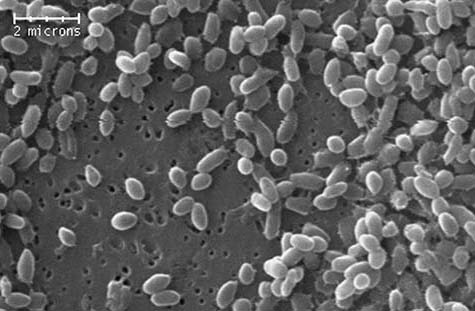

"Some researchers believe that mitochondria were required to deliver enough energy for phagocytosis to work. Which came first? Was it the mitochondria, which originated from another group of bacteria and became our cells' own energy factories? Or was it phagocytosis, which is considered necessary to absorb mitochondria but is very costly from an energy standpoint? Which has implications for a hot chicken-or-egg debate in evolutionary biology about how eukaryotes came into being. This means that phagocytosis is at least as old as Legionellales - two billion years old - when eukaryotes were in the early stages of their evolution.

That suggests that the ability to infect eukaryotes already existed in the ancestor of all Legionellales. In the study, the researchers show that all Legionellales have the same kind of molecular tools as legionella. But legionella bacteria have molecular tools that keep them from being digested and allow them to instead use the amoeba as an energy source so they can multiply. The next step for the amoeba would be to digest the bacterium and use its parts as an energy source. The first step in an infection with legionella bacteria is for a eukaryotic host, such as an amoeba, to bring the bacterium into its cell through a process called phagocytosis. "We believe Legionellales were among the first to infect eukaryotic cells." "We discovered that the ancestor of the whole group lived about two billion years ago, at a time when eukaryotes were still in the making, evolving from simpler cells to the complex cell structure they have now," says Andrei Guliaev, a researcher at the Department of Medical Biochemistry and Microbiology. All Legionellales bacteria can infect eukaryotic hosts: amoebas, insects or our own cells. The legionella bacterium, which causes Legionnaires' disease, belongs to a large group of bacteria called Legionellales. Instead, they began using eukaryotic cells - complex cells with a nucleus that make up amoebas, fungi and human beings - to multiply. Two billion years ago, ancestors of legionella bacteria already had the ability to avoid being digested by eukaryotes. Membrane potentials can also be generated by flow of electrons."Our study can help us understand how harmful bacteria arise and how complex cells evolved from simpler cells," says Lionel Guy, associate professor of evolutionary microbiology at the Department of Medical Biochemistry and Microbiology, who headed the study. Even under these circumstances, a large change in pH is prevented because the positive charge on the outside surface inhibits further efflux of protons. To generate a membrane potential, some of the protons could be electroneutrally released to the outside of the cell to create a pH change and remain at the outer membrane surface to create a membrane potential. Because animals evolved in seas filled with bacteria and have lived in close association with bacteria. This can happen with the transport of both proton and counter-ion or the exchange of a proton for a corresponding positively charged cation. The first bacteria evolved more than 3 billion years ago and dominated the biosphere continually thereafter, shaping the environment in which animals would eventually evolve more than 2 billion years later (Narbonne 2005 Knoll 2011). Each proton (H+) on the outside of the cell must have a negative counterion (A-).

The outside of the cell can become acidified, but electrical neutrality must be conserved. The first dinosaurs evolved about 230 Ma (a specific date). The electrical and chemical potential cannot develop simultaneously. Constantly writing out millions and billions of years is time-consuming, so when geologists. Chemical: proton concentration gradientĮlectrochemical energy (Δμ) is the sum of changes in both the electrical and chemical energies (Image credit: UCLA Center for the Study of Evolution and the Origin of Life) Wedged. Work can be done when the proton moves into theĬell in the same direction as the electric field. These sulfur bacteria haven't evolved for billions of years. Energy stored in the proton gradient exists in two forms:


 0 kommentar(er)
0 kommentar(er)
